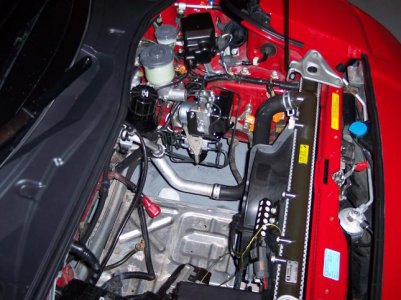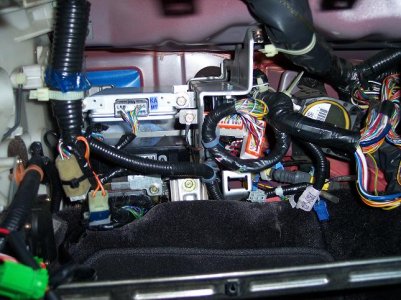I had recently completed upgrading my ‘91 NSX’s ABS to the NA2 system using the SOS ABS Upgrade Kit and thought I would share my experience with others who are contemplating such a project. During the project, I referenced commentary/posts from NSXPrime to aid me in the completion of the project and want to add to the pool of information to help others.
First some background, although I absolutely love my NSX the one facet that has bugged me was the temperamental ABS unit. Up North, the winters are rather long so my fun cars take lengthy hibernations. My other “toy” is a S2000 so when time comes to pull it out of storage, I simply start it up and drive it diligently until I burn off the “old” fuel. That’s it; however, with the NSX, the ABS solenoids seem to stick and I have to fiddle with the system to get it working correctly (you can see the reference at Danoland for a good explanation of what to do). I got a bit fed up with the process and decided to take the plunge and upgrade the system. Now, I believe that the upgrade is recommended IF your ABS has failed completely. Mine hadn’t, but it I did reach a point of significant frustration. Midway through the project, I realized why the recommendation is for FAILED units because the project takes a fair amount of time and patience.
Prior to the purchase I had called SOS and briefly spoke to Chris who was extremely pleasant and helpful in answering questions. Once I received the kit, I spent a good while studying the instructions and correlating them with the service manual. After I was comfortable with the whole process, I began embarking on the project. It took me a solid 7 days of at least 7 hours a day to complete. Admittedly, I did address a few niggling annoyances along the way (ie. Creaking climate control servo & a broken tab), but those only consumed a total of two hours. Also, I was very diligent in the whole process for I did not want to scratch or damage the car’s finish during the process.
Some general commentary:
-There are no special tools required; however, as others mentioned a 10mm open (flare) box-wrench is mandatory. The kit from SOS has all the parts you need. You just need to supply the tools, brake fluid, and talent.
-The brake lines do have some “give” to them and you can bend them gently to make them fit. I would practice on the old lines that you remove to get a sense of the pliability of the lines.
-I would also recommended purchasing a fair amount of Honda brake fluid (or whatever you prefer) prior to the project because you will be bleeding the system quite a bit. I actually had to bleed the system at least 4 times to finally get it nice and firm. After becoming frustrated with the mushy feeling, I purchased a set of Speedbleeders and the final bleed session with them did the trick. They now feel awesome!
-Prior to re-assembling the dash, I would recommend taking the car out for a drive to make sure you address any potential issues or noises that may surface. It is easier to address them while the dash is apart than after you spent an hour or two putting it all back together.
Now some issues that I encountered during the install that I would share with others should they run into similar scenarios.
-After the complete install and first brake bleeding, I started up the car and system did not work. The ABS & TCS lights came up and would never extinguish. After a lengthy troubleshooting session, I found that there was a single wire in the SOS harness (under the dash) that had broken off from the connector. In particular, it was the ground lead so the relay was not activating to deliver power to the ABS modulator. After re-soldering the wire, voila! It worked! Fortunately, just after I re-soldered the lead a torrential rain came through and was done after a second brake bleeding so I was able to take the car out for a spin. I did multiple runs where I stomped on the brakes at 25 & 40mph and the car came to a very controlled, quick stop. Like others mentioned, the ABS does feel different from the original.
-I re-bled the system a 3rd time to improve the mushy feeling to some success. Once, I had completed the 3rd brake bleeding session, I figured I was done, however, while at a stop light my brake pedal dropped to the floor. After some research, I realized that my master cylinder had failed. A quick call to Tim @ Ray Laks Acura and new master cylinder was shipped and now things are all well. For reference, I don’t believe that the new ABS unit was a cause of the master cylinder failure, rather I believe it was age for the prior owner kept meticulous records and there was no listing of a replacement.
-As many other’s have mentioned on the forum, if your brakes feel soft/mushy and you have no leaks, you most likely have some air in the system. I took heed with their comments and must agree that they are right.
There were a number of times during the project that I felt like I was in over my head. When that occurred, I stepped away from the car and took a break to gather my thoughts. In the end, the whole project was genuinely worth it to me.
I attached a photo of the completed, secured wiring harness that resulted in the least amount of noise (for me) and the completed ABS modulator install for reference.
First some background, although I absolutely love my NSX the one facet that has bugged me was the temperamental ABS unit. Up North, the winters are rather long so my fun cars take lengthy hibernations. My other “toy” is a S2000 so when time comes to pull it out of storage, I simply start it up and drive it diligently until I burn off the “old” fuel. That’s it; however, with the NSX, the ABS solenoids seem to stick and I have to fiddle with the system to get it working correctly (you can see the reference at Danoland for a good explanation of what to do). I got a bit fed up with the process and decided to take the plunge and upgrade the system. Now, I believe that the upgrade is recommended IF your ABS has failed completely. Mine hadn’t, but it I did reach a point of significant frustration. Midway through the project, I realized why the recommendation is for FAILED units because the project takes a fair amount of time and patience.
Prior to the purchase I had called SOS and briefly spoke to Chris who was extremely pleasant and helpful in answering questions. Once I received the kit, I spent a good while studying the instructions and correlating them with the service manual. After I was comfortable with the whole process, I began embarking on the project. It took me a solid 7 days of at least 7 hours a day to complete. Admittedly, I did address a few niggling annoyances along the way (ie. Creaking climate control servo & a broken tab), but those only consumed a total of two hours. Also, I was very diligent in the whole process for I did not want to scratch or damage the car’s finish during the process.
Some general commentary:
-There are no special tools required; however, as others mentioned a 10mm open (flare) box-wrench is mandatory. The kit from SOS has all the parts you need. You just need to supply the tools, brake fluid, and talent.
-The brake lines do have some “give” to them and you can bend them gently to make them fit. I would practice on the old lines that you remove to get a sense of the pliability of the lines.
-I would also recommended purchasing a fair amount of Honda brake fluid (or whatever you prefer) prior to the project because you will be bleeding the system quite a bit. I actually had to bleed the system at least 4 times to finally get it nice and firm. After becoming frustrated with the mushy feeling, I purchased a set of Speedbleeders and the final bleed session with them did the trick. They now feel awesome!
-Prior to re-assembling the dash, I would recommend taking the car out for a drive to make sure you address any potential issues or noises that may surface. It is easier to address them while the dash is apart than after you spent an hour or two putting it all back together.
Now some issues that I encountered during the install that I would share with others should they run into similar scenarios.
-After the complete install and first brake bleeding, I started up the car and system did not work. The ABS & TCS lights came up and would never extinguish. After a lengthy troubleshooting session, I found that there was a single wire in the SOS harness (under the dash) that had broken off from the connector. In particular, it was the ground lead so the relay was not activating to deliver power to the ABS modulator. After re-soldering the wire, voila! It worked! Fortunately, just after I re-soldered the lead a torrential rain came through and was done after a second brake bleeding so I was able to take the car out for a spin. I did multiple runs where I stomped on the brakes at 25 & 40mph and the car came to a very controlled, quick stop. Like others mentioned, the ABS does feel different from the original.
-I re-bled the system a 3rd time to improve the mushy feeling to some success. Once, I had completed the 3rd brake bleeding session, I figured I was done, however, while at a stop light my brake pedal dropped to the floor. After some research, I realized that my master cylinder had failed. A quick call to Tim @ Ray Laks Acura and new master cylinder was shipped and now things are all well. For reference, I don’t believe that the new ABS unit was a cause of the master cylinder failure, rather I believe it was age for the prior owner kept meticulous records and there was no listing of a replacement.
-As many other’s have mentioned on the forum, if your brakes feel soft/mushy and you have no leaks, you most likely have some air in the system. I took heed with their comments and must agree that they are right.
There were a number of times during the project that I felt like I was in over my head. When that occurred, I stepped away from the car and took a break to gather my thoughts. In the end, the whole project was genuinely worth it to me.
I attached a photo of the completed, secured wiring harness that resulted in the least amount of noise (for me) and the completed ABS modulator install for reference.







